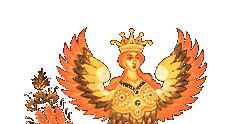The Isle of Buyan as manipulated by the Russian ballad-writers, becomes something like the mysterious Isle of Youth or the Isle of St. Brandan, Tir n'an Og of the Celtic stories.
The word Buyan is clearly of Russian origin. The root, means to blow, and as applied to a forest's movement, signifies vigorous forest: as applied to corn, thick corn.
In the adjectival form buiny is used as an additional epithet for the head of almost every single hero and hero and heroine, who all of them have "unruly heads"; another adjectival form buyany meaning much the same as buiny.
In the Government of Tula there is a word buidazh which means an open space on the top of a hill. The connection is clearly "boisterous", wind-swept."
In the early Russian ballads the invariable formula is Na ostrove na Buyane ("on the island of Buyan,") but it is highly probable that Buyan became a substantive only later, and at first was adjectival and meant "on the windy island." Lovers of nature-myth have at once seen in this phrase a symbolization of the passing cloud; this may be party true, and such a metaphorical use is feasible. At the same time the conception of some mystic island of happiness set in the middle of the ocean is a universal conception, and the two ideas may have blended.
On this island of Buyan (according to the ballads contained in the Wandering Friars) there are very many mystic things to be seen. There is the stone Alatyr, the mysterious bird Strafil, Indrikh "The king of beasts," always undescribed; and above all the mighty fish Kit, the Whale, which is the mother of all fishes, and on whom the whole of the moist earth is founded; when this fish shall drown, all the moist earth will fall to pieces. Lying on this island is the Book of the Dove, which is dealt with above.
In the folk tales the Fairy City of Filuyan is found similar in form and conception. The derivation must be...
In my opinion there is little doubt but that Buyan is the Island of Rugen (in Old-Russian Ruyan ). Rugen is derived from the Teutonic root seen in " rough, ", and so corresponds in meaning with Buyan . It was the principal center of the Slavonic and Wendish worship, and contained the great Temples of Yarovit and the deities, who were finally destroyed by Valdemar of Denmark between 1171 and 1175.
In Pagan times Rugen was a place of pilgrimage: it was close by the commercial centers of the Baltic, and the recollections would have survived in folklore. It is pertinent to add that it is quite probable that the Wends were Celts; if so, this would account for the strong tincture of Celtic in Russian folklore.
|



